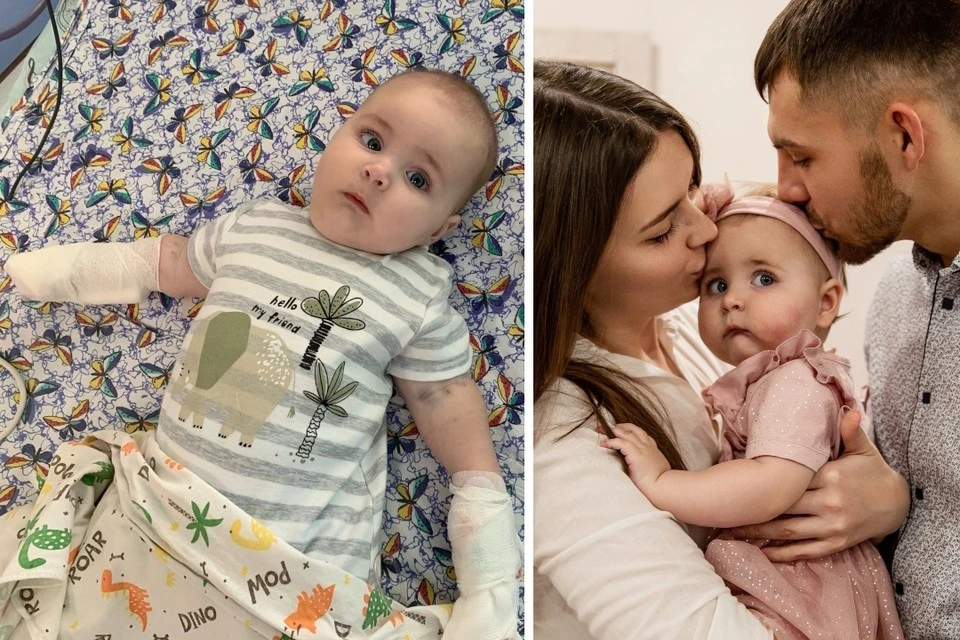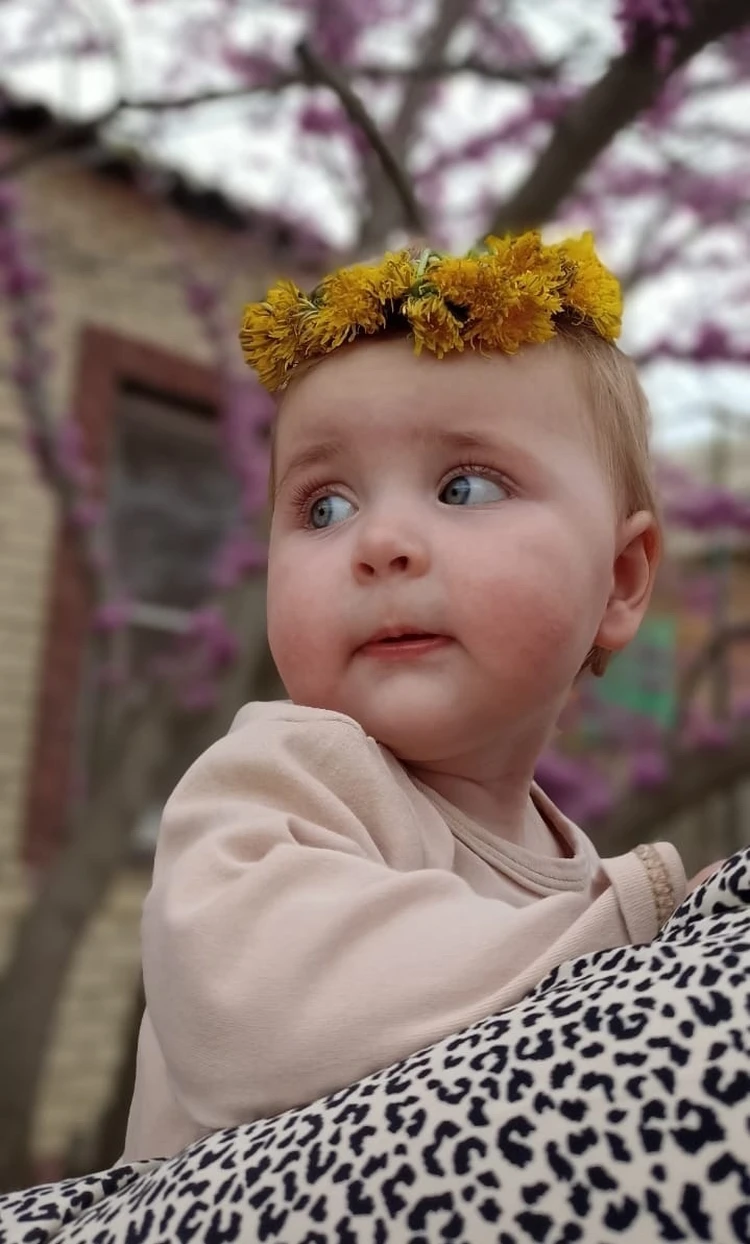"Every day could be the last...": A mother from Taganrog shares her story about life after the world's most expensive "life-saving injection" for her daughter.
 9
9The little girl received the "shot of life".
Photo: Personal archive of the publication's hero.
Nearly two years ago, the life of 30-year-old Anna Dovbnya from the Rostov region changed dramatically. Not only because she became a mother for the first time, but also due to her daughter Polina's severe illness that could take her life at any moment.
To save her child, the most expensive medication in the world, often referred to as the "shot of life," was required. Fortunately, the little girl received it, and her mother shared with "KP - Rostov-on-Don" the challenges that Polina and the entire family faced in their fight for her health.
 0
0The girl is very happy as she learns a new skill.
Photo: Personal archive of the publication's hero.
“SHE'S JUST LAZY”
- Polina is our first planned and wanted child. My husband Artem and I never thought that our daughter would face such a tragedy, - Anna admits. - The pregnancy went perfectly, and the doctors said it was ideal. I wasn't even bothered by morning sickness! The test results and ultrasounds indicated that everything was fine and the baby was developing well.
Polina was born on January 12, 2023. Just a few days later, her happy husband brought his wife and their lovely daughter home. Everything seemed perfect.
- I thought my daughter was acting sluggish and weak. Due to my inexperience, I didn’t pay much attention to it: she was eating well, gaining weight, and developing according to her age. Besides, Polina was regularly monitored by a pediatrician, who reassured me in response to my concerns: “She’s just lazy.” However, when another doctor examined us, he noticed that the baby had no reflexes that should be present—like walking, and she couldn’t hold her head up, her eyes would roll back.
 1
1The girl has fashionable plastic boots to properly secure her legs during exercises in the verticalizer.
Photo: Personal archive of the publication's hero.
SCREENING DID NOT REVEAL GENETIC DISORDERS
Parents scheduled an appointment with a neurologist. The doctor urgently referred them to the regional children's hospital. In Rostov, the baby was hospitalized for examination.
- The head of the department suggested that this might be spinal muscular atrophy (SMA). To verify this, they took a blood sample from Polina and sent it to Moscow for analysis.
As doctors explain, spinal muscular atrophy refers to a group of diseases characterized by progressive weakness, atrophy, and paralysis of muscles due to damage to the spinal cord's nerve cells. Those with SMA lose the ability to control their bodies, potentially leading to complete immobility. As the disease progresses, they cannot swallow or breathe independently.
- While waiting for the results from Moscow, my husband and I, along with our family, reassured ourselves that Polina had undergone neonatal screening at the maternity hospital. At that time, blood was taken from her heel and tested for dozens of congenital disorders. None of the genetic diseases on the list, including SMA, were confirmed.
 2
2The little one is gradually gaining strength in her arms.
Photo: Personal archive of the heroes.
“IT FELT LIKE THE GROUND HAD SLIPPED FROM UNDER ME”
But the hopes were in vain. At the age of four months, Polina was diagnosed with the terrifying spinal muscular atrophy.
- The positive result came, but the first test done right after birth turned out to be a false negative. It felt like the ground had slipped from under me. I had no idea how to live on, where to run, what to do, and how to build our life. All hopes were shattered in an instant.
The doctor began to reassure the parents: he explained that there is treatment available and discussed three medication options we could choose for Polina. The first needs to be taken daily, the second requires injections into the spinal cord every four months, and the third is a one-time infusion.
- Considering all the complexities and the huge number of side effects, we chose the third option—the medication "Zolgensma."
This medication is administered once and is commonly referred to as the "shot of life," which can save a patient with SMA from death. It is also the most expensive drug in the world.
- At the time we learned about Polina's illness, the medication cost around 2.1 million dollars. I had no idea how to raise such an amount. Moreover, the sooner the drug is administered, the better—because the child was getting weaker every day. I imagined having to start a multimillion-dollar fundraiser. Asking for help is incredibly difficult, and I don't think anyone is ever prepared for that.
 3
3The little girl can sit up by herself for a couple of minutes.
Photo: Personal archive of the heroes.
“WE JUST WAITED. AND THAT WAS THE SCARIEST PART”
But the doctor advised them to contact the charity fund "Circle of Good" that helps children with rare diagnoses. Through the clinic, the family began submitting requests to obtain this medication.
- For the next three months after the diagnosis, we simply waited. And that was the scariest part. Every day, the baby's motor neurons were dying, worsening Polina's condition: her swallowing and breathing functions could stop at any moment. One day, I realized that her arms were completely limp—hanging like rags, her legs were still—she could only move her feet. Fortunately, she was still able to breathe and eat on her own. But each day could be her last...
At six months, a call came from a Moscow clinic: the funds for the long-awaited infusion had been secured. By that time, the girl had become almost bedridden. However, when her parents brought Polina to the doctors, she and her mother had to wait almost a month in the hospital. Due to sanctions, the "shot of life" was delayed, and the medication was administered when she was nearly seven months old.
- The infusion was given on August 4, and just three days later, I noticed that Polina was reaching for toys, raising her arms in a way she had never done before. For me, it was a true miracle! Looking at other SMA children in the clinic, I realized that we were very lucky, as our daughter turned out to be quite a strong child.
Of course, such a powerful medication has a multitude of side effects.
- Almost all internal organs are affected. The medication has a significant impact on the liver. For many months, we had to give the little one a hormonal medication to normalize liver function and blood clotting.
 4
4Polina and her fluffy friend Barsik are almost the same age.
Photo: Personal archive of the publication's hero.
“I DON'T COMPARE HER WITH HER PEERS”
Despite the common myth, the "shot of life" does not enable a child to walk. But it prevents the disease from progressing, literally reclaiming the child from death.
- When we realized that the danger had passed, it certainly became easier mentally. However, after this medication, the child will not miraculously stand up and walk. I do not compare my daughter with her peers: Polina develops at her own pace. She is almost two years old now and still doesn’t walk or crawl, but she is able to roll over onto her stomach, tries to lift her head a bit while lying on her tummy—this is one of our achievements—she can raise her legs well, her arms are functioning, and she can sit up by herself for a couple of minutes, and during the day, she can be in a supportive corset.
Her mother explains that each new skill is hard-earned for her daughter, thanks to regular rehabilitation sessions at clinics, massages—Anna has taken special courses—and standing in a verticalizer—currently, Polina